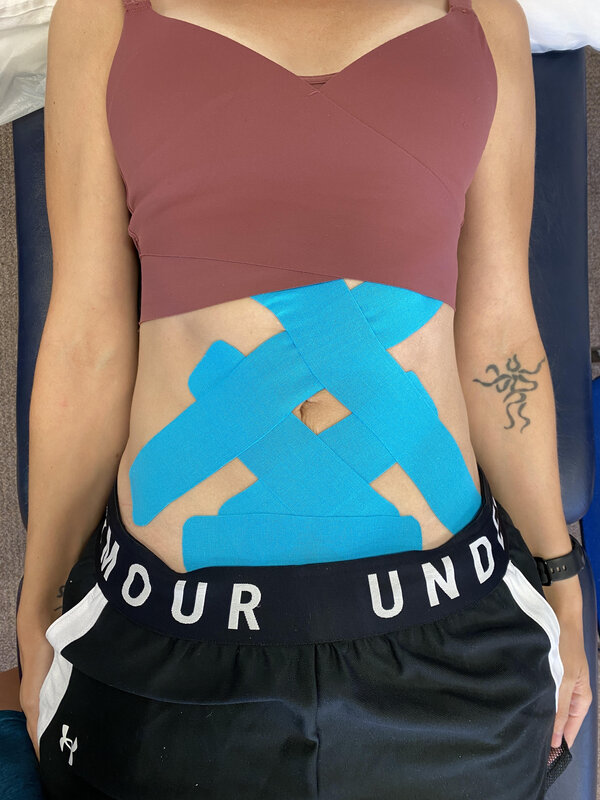Kinesiology taping, often simply referred to as “KT taping,” is a versatile and effective technique that can make a world of difference in your physical well-being. I recently discovered this on a Rocktape course and while I’d used it informally to help my husband recover from injuries (he’s really too old to be playing basketball still…) this really helped me understand how much more I could use it to help my clients.

What is Kinesiology Taping?
Kinesiology taping involves applying a specially designed tape to various areas of the body. By changing the stretch and how it’s applied, you can change its purpose.
This tape is unique because it mimics the elasticity of human skin, allowing for a wide range of motion without restricting your movements. It’s a non-invasive and drug-free approach to addressing a variety of physical issues.
How Can Kinesiology Taping Benefit You?
KT taping offers a host of benefits, including:
- Pain Relief: It may reduce pain by “pain-gating”. This interrupts or inhibits a more threatening sensory input. Put simply, if you’re afraid of bending because of lower back pain, having tape over that area can provide a new sensation which interrupts your subconscious fear of bending. Which means you might be able to move more freely. Pain relief can also come about through gentle decompression from the tape due to soft tissue laxity and offloading.
- Improved Support: It can provide support to muscles and joints, reducing the risk of overuse injuries and promoting faster recovery.
- Reduced Swelling and Inflammation: Taping has been used to aid swelling (oedema and lymphedema).
- Postural Correction: It can assist in correcting posture-related issues by providing gentle reminders to keep your body aligned.
- Movement influence: Taping can capture the brain’s attention as it’s a new sensation on the skin. This can improve proprioception, as well as balance, and also delay muscle fatigue.
Who Can Benefit from Kinesiology Taping?
Kinesiology taping is suitable for a wide range of individuals, including:
- Athletes: Whether you’re a professional athlete or enjoy recreational sports, KT taping can support your performance and recovery.
- Pregnant Women: Specialised taping techniques can alleviate discomfort during pregnancy and support your changing body. For example, sacroiliac joint pain, or bump support.
- Postnatal Women: Abdominal taping can help improve diastasis recti recovery, flat feet and posture.
- Everyday Warriors: If you’re a busy mum or simply someone looking for a drug-free pain relief solution, kinesiology taping can be a game-changer.
- Injury Recovery: Taping can help with ACL recovery, as well as conditions such as Mortons Neuroma which can be caused by cycling or running.

How I Use Kinesiology Taping at The Warrior Method:
Taping has to have a personalised approach. I offer it alongside personal training and sports massage where appropriate.
Message me to book in a personal training or sports massage session.
IMPORTANT: Kinesiology Taping can improve many conditions, but it can often be a case of trial and error. It’s not recommended as a solution in itself, and often works best when combined with movement e.g. stretches, rehab exercises.

FAQs
What are the tapes made from?
Each brand of tape has a slightly different composition. I generally use Rocktape which is 97% cotton and 3% nylon with a hypo-allergenic, acrylic based adhesive that’s free of latex.
I also use Tiger Tape which is 100% cotton and latex-free.
How long does taping last for?
The effects of taping are felt immediately. The duration depends on how long your brain gets used to the new sensation, as well as the integrity of the tape and where it’s positioned. It’s not recommended to wear it for more than 24hours, especially if you have an active lifestyle.
Will I react to the taping?
Some people can experience itchinesss and / or redness around or on where the tape has been applied. If you find the tape is itchy or painful, please remove it immediately.
Is it painful to take off?
This depends where the tape is positioned on your body (some areas are more sensitive than others), as well as the amount of hair and your pain tolerance. There are methods which can be used to help reduce the discomfort when removing the tape.
Can I do it myself?
Where suitable, if you’d benefit from regular taping for an ongoing condition, I can teach you how to tape yourself. Obviously, there are some areas which are harder to tape on yourself than others!